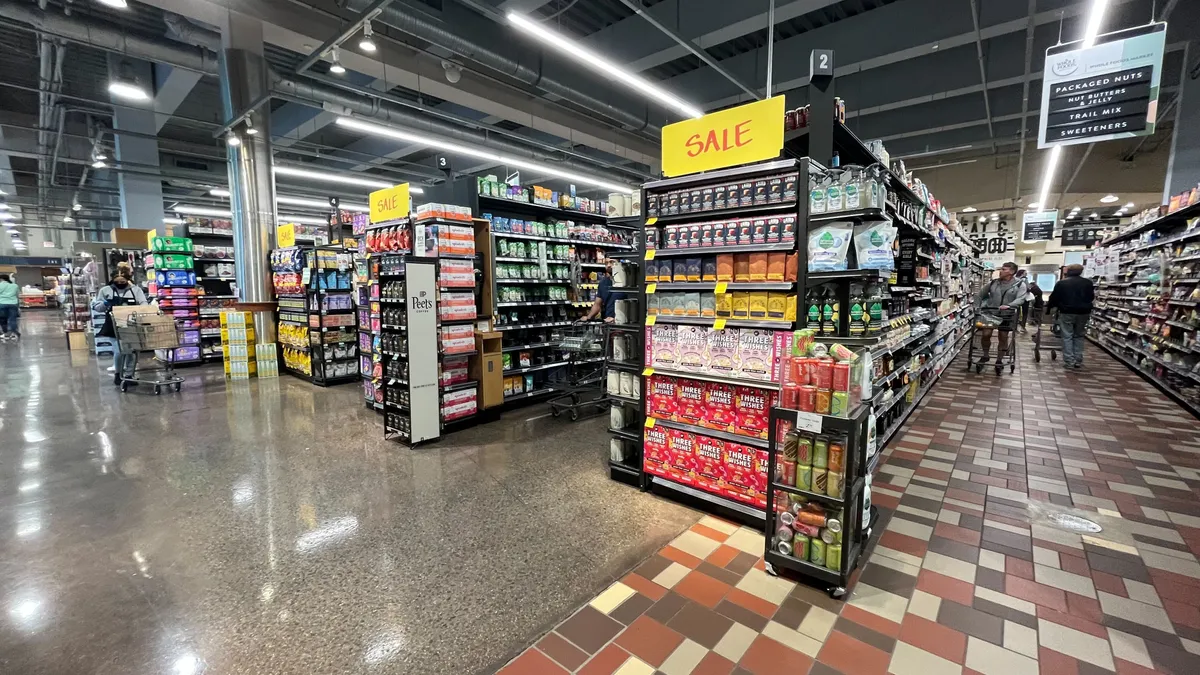Dive Brief:
- Amazon’s acquisition of Whole Foods has introduced a new era in retailing that will require grocers to tighten up their operations and develop a more distinct identity in the marketplace, according to strategist Ken Lonyai, writing in RetailWire. This includes developing unique private label offerings and ensuring out-of-stocks aren’t happening in stores.
- Retailers also need to speed up their checkouts and reduce their number of SKUs to reach a targeted audience with more high-impact products, Lonyai writes.
- “Resilience and profitability are more achievable by targeting a narrow band of customers with a reduced, highly relevant product mix and operating more like a vertical that serves that segment superbly,” writes Lonyai. “Being average to everyone is no longer an option.”
Dive Insight:
Amazon certainly has the potential to transform grocery retailing, but for the time being it remains one of a number of competitive challenges facing supermarkets. Rather than focus on an Amazon-specific strategy, grocers need to develop — if they haven’t already — a strategy that addresses a crowded, price-competitive market that stands to punish undifferentiated stores.
Does this mean retailers need to invest heavily in technology upgrades and new product lines? Not necessarily. Rather than try and go toe-to-toe with the likes of Amazon and Walmart, retailers can accomplish a lot by improving what they already do. As Lonyai notes in his RetailWire piece, grocers have to eliminate out-of-stocks and better merchandise their private label offerings. With more choices than ever out there, customers will turn away from retailers that fail on execution, or that don’t offer compelling low-cost alternatives.
Consider the case of Market Basket in New England. Most know the regional grocer through the saga that unfolded three years ago, in which workers and customers went on strike following the ouster of popular CEO Arthur T. Demoulas. But the company, which was eventually sold to Demoulas for $1.5 billion, is better known these days as a supermarket that’s drumming technologically advanced retailers with a very basic, well-executed game plan. This includes offering low prices and friendly customer service, frequently replenishing shelves and having good relationships with suppliers. It’s an old-fashioned approach — so old-fashioned, in fact, that Market Basket still doesn’t have a website (a dedicated customer posts the store’s circular on a separate site each day).
Old-school retailing is Market Basket’s identity in the marketplace. Other retailers need to determine theirs, and they need to consider strategic investments that will help them along. Many conventional retailers are remodeling their stores to incorporate more fresh products, attractive signage and better layouts. This is a good step for middle-of-the-road retailers, but with so many players updating their stores, companies need to make sure they’re doing so with purpose and distinction in mind.
There are other must-dos in this new retailing landscape, including offering some sort of e-commerce platform. This has become table stakes, as Lonyai points out, though a crucial step to maintaining market share as demand for online shopping grows.
Speeding up checkout is another important step retailers of all sizes must make. At a time when shoppers can buy at the click of a button, standing in long lines at a store’s front end has become incredibly frustrating. It would be one thing if grocers had to spend millions of dollars and upend their store layouts — but, in fact, mobile technology is advancing a new form of self-checkout that’s helping shoppers skip the line altogether. Walmart and Sam’s Club have implemented this technology, and so too have small chains like Macey’s in Utah.
Ultimately, even if Amazon-Whole Foods manages to become a dominating force in food retail, there will still be plenty of market share for other grocers to claim. Retailers need to improve their operations now to make sure they’re still relevant in a quickly evolving grocery landscape.










